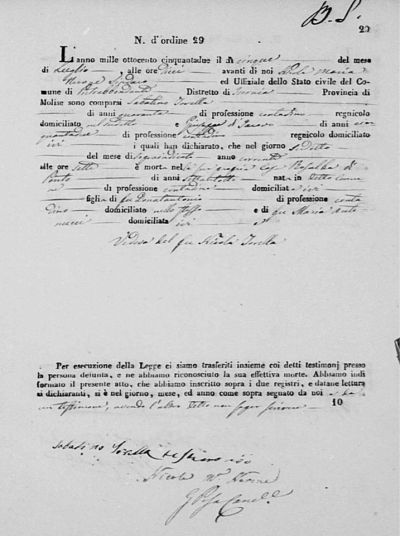Negli ultimi anni sono state avviate iniziative molto interessanti che hanno considerevolmente semplificato la ricerca remota di Atti di Stato Civile negli archivi italiani, permettendo cosi di risalire con maggiore efficienza a documenti essenziali per condurre ricerche genealogiche per scoprire e proteggere il retaggio familiare. Gran parte del merito va alla Chiesa di Gesù Cristo dei Santi degli Ultimi Giorni, che ha digitalizzato i propri archivi lanciando un progetto che mira ad ampliare la disponibilità di documenti consultabili in rete.
Two very exciting initiatives have occurred in the past few years that make finding your ancestors in Italian civil records much easier than ever before. For many of us, the days of traveling to Italy or having to write to Italy for information from civil records and then waiting (and waiting) for the results is a thing of the past. Much credit goes to the Church of Latter Day Saints for digitizing their holdings of Italian records and the country of Italy which is making millions of records searchable and viewable online.
First a little history is needed to help you understand which types of civil records exist. The main types are birth, marriage and death records. There are other records, which we will cover in future columns, but these are the big three. The civil records contain a lot of valuable genealogical information. In birth records (Atti Di Nascita) you will see the date of birth, parents’ names, the parents’ ages, and their occupations. It was usually the midwife (levatrice) or father who provided the information for the record. Some birth records also state the name of the grandfather, thus giving you three generations. In death records (Atti Di Morte), you will find the date of death, age at death, occupation, parents’ names, and the names of a spouse. In the marriage records (Atti Di Matrimonio), you will find similar information such as the date of the marriage, ages of the parties and names of the couple’s parents and sometimes grandfathers. Additionally, records, particularly later ones, will have the names of witnesses. Often witnesses were other family members which helps to build out our family tree branches even more! Civil records can go back as far as 1806. The Catholic church recorded vital records even earlier, however they are not as easily accessible as the civil records.
There are three important periods to know about when and where civil records were created in Italy. Original records are kept in the villages in which they were created and another copy can usually be found in the Province’s archives.
Stato Civile Napoleonico (Napoleonic Civil Records)
When Napoleon Bonaparte gained control of most of Italy (except for Sicily, Sardinia and South Tyrol) he ordered that all birth, marriages and deaths be recorded by the civil authorities. The earliest records begin in 1806 with most beginning by 1810. The records are written in Italian and exist through 1815, when Napoleon was defeated.
Stato Civile Restaurazione (Restoration Civil Records)
These records were created during the reign of the Kingdom of the Two Sicilies and cover the period 1816-1865. They are also written in Italian. The area encompassed by these records includes the southern Italian peninsula. Sicily was under Bourbon control and therefore it did not begin civil registration until 1820. As for Northern Italy, unfortunately, many of the provinces did not keep civil records during this entire time. Some, however, began record keeping again in the 1840s.
Stato Civile Italiano (Italian Civil Records)
In 1866 the provinces and regions unified into what we know today as Italy. These will likely be the records you will start with when you begin to research your immigrant ancestors who were born in Italy. When I first began my search, I was not certain of the dates of birth of my great-grandparents. It was the discovery of my grandfather’s 1885 birth record that showed his parents’ names and their ages, this then led me back to finding the birth records of my great-grandparents.
What You Need to Have When You Start Your Search
You will need to have three basic pieces of information to start your search. First your ancestor’s Italian name, their ancestral village and date of birth or a range of years to search. Sometimes the hardest part is figuring out where a record was recorded. For example, my grandmother was born in Castiglione di Carovilli. There are several villages named Castiglione, so I needed to know the province and the region to narrow it down. Records for our Castiglione were found in digitized images of record books that contain the records for it and nearby Carovilli in Molise.
Where to Find the Records
At the Church of Latter Day Saints’ Family History Centers or library affiliates you can view their digitized records. If you are new to research, I recommend that you visit a Family History Center, where volunteers are available to assist you.
To find a Family History Center near you, visit www.familysearch.org/locations. If you have a bit more experience with research and can read some Italian, you can search and view records online at http://dl.antenati.san.beniculturali.it/en/gallery. Over the next several months, I will be doing a deep dive into each type of record and providing lots of tips, so stayed tuned as we journey together to unlock your family history back in the old country!



